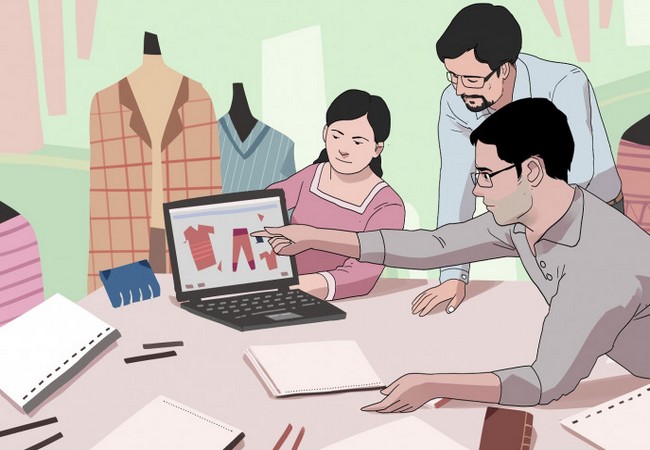Who is Garments Merchandiser?
A garment merchandiser is the one who plays the role as a middleman between buyer and apparel manufacturing industry. He has to look after every portion of an export order i.e. order confirmation to shipping the products to the buyer. In this competitive era of garments manufacturing business, an expert apparel merchandiser has great importance in executing these orders. As its importance, I have presented here the top 22 tips to become an expert apparel merchandiser.

How to Equip and Educate Oneself to Become an Expert Apparel Merchandiser?
The below guidelines should be followed by an apparel merchandiser to become an expert in garments merchandising:
1. Good knowledge on English language in both written and spoken.
2. Know the email writing techniques.
3. Know the world map and all sea and air route.
4. Know about all types of fibers used in textile and apparel industry-
Natural fibers: Fibers from cotton, Jute, Hemp Ramie, Flax Plant (to produce Linen) Manila hemp, henequen, Yucca, Agaves, Pineapple, Sugarcane, Palm Tree, Date Tree Leaves etc.
Animal Fibers: Sources are sheep, Angora Goats, Kashmir Beavers, Ruminant (Rock Mountain Goats), Antelopes 9 Various types of deer).
Mineral Fibers: Glass fiber (made from silica sand) Resin Quartz, Ceramic Fiber (Aluminum oxide), Silicon Carbide, Boron Carbide mainly used for heat resistant composite materials components of helicopter, military and civil aircraft, missile, space craft, satellite, space shuttle.
Synthetic Fiber: Rayon’s (natural cellulose made from wood pulp treated with chemical to form a thick liquid then it is bathed in weak acid to form pure fiber, citrate and triacetate are true synthetic fiber, Polymer, Nylon, Acrylic , Carbon and Graphite (this is processed in 2500 degree Celsius to form very strong substance and is used for Bullet proof garments.
5. Know all types of woven and knitted Fabrics weaving / Knitting Pattern:
Woven Fabric: The weaving patterns are poplin, Oxford, Twill, Dobby, Jacquard, Corduroy, Checks and Plaids.
Knit Fabrics: The Knitting patterns are: Single Jersey, Rib, Interlock, Pique, Fleece, French Terry, Variable Ribs, Drop needle, Pointal etc.
6. Know all types of Printing:
- All-Over Print,
- Screen Print,
- Reactive Print,
- Print with Plastisol dye stuffs,
- Discharge print,
- Pigment print,
- Flock print,
- Foil Print,
- Lurex Print,
- Embossed Print,
- Heat transfer Print,
- Hi-Density Print,
- Dip-dye Print.
7. Should be able to differentiate all types of Embroideries.
- Plain embroidery with one color,
- Plain embroidery with multi-color,
- Embroidery with Lurex thread,
- Embroidery on printing,
- Embroidery with Application,
- Embroidery with application over application,
- Embroidery with laser cut design,
- Embroidery with sequine setting.
8. Should know all samples and their implications:
- Photo sample,
- GFE sample,
- Counter sample,
- Sealed /Red / Yellow label sample,
- Size set sample,
- Pre-Production sample,
- Lab test sample,
- Flammability test sample,
- Photo shoot sample,
- Salesman sample,
- Shipment sample,
- Top of the product sample (TOP).
9. Know all lab test Requirements:
- Shrinkage / Dimensional stability test,
- Pealing test,
- Crocking / Rubbing test (Dry /wet),
- Perspiration test,
- Color Fastness to Light,
- Cross staining test,
- Washing Fastness test,
- Saliva test (for children’s ware),
- Tensile test,
- Test of Bursting of Fabric,
- Test of presence of AZO, PVC, Formaldehyde or any other carsegonic substance in the garments.
10. Keep record of all yarn, fabric and accessories supplier.
11. Know all sea and Air Freight Forwarder.
12. Know all feeder and Mother Vessel schedule.
13. Keep updated records of Container charges (20 feet, 40 feet, 40 feet high cube, and 45 feet high cube).
14. Keep records of all good printing and Embroidery factories.
15. Keep Records of all factories of printing, embroidery, hanger, labels, laces, elastic, poly, cartons etc.
16. Keep records of all spinning mills, knitting mills and dyeing factories with their machine and production capacity.
17. Acquire good knowledge on consumption and costing.
18. Keep commitment with all buyers and suppliers.
19. Make a habit of replying all mails without wasting any time.
20. Be sincere to your duties.
21. Never do anything on assumption always get clarification and keep written records with date and time.
22. Always show positive attitude to resolve all problems. Always check all booking of fabrics and accessories before and after sending; if possible get it checked by third person.
-Written By:
Eng. Faruq Hosen
Sr. Lecturer,
BGIFT Institute of Science and Technology

Mayedul Islam is a Founder and Editor of Garments Merchandising. He is an Expert in Garments Merchandising. Writing is his passion. He loves to write articles about Apparel, Textile and Garment Washing specially on Merchandising. Mail him at mayedul.islam66@gmail.com

